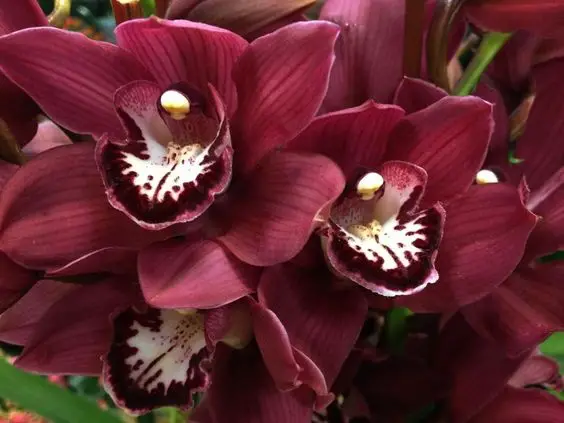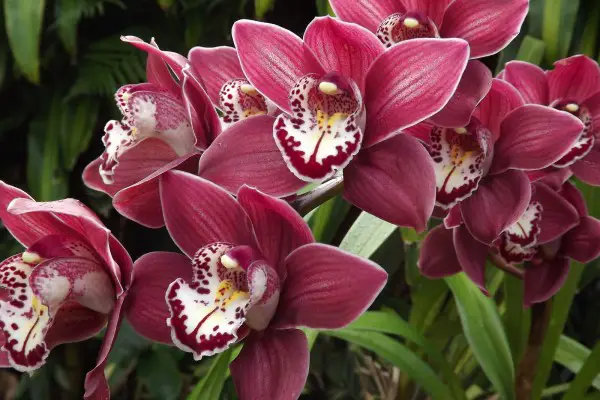LATIN NAME: CYMBIDIUM ATROPURPUREUM
Primary genus: Cymbidium

| motherland | Malaysia Philippines Thailand Borneo |
|---|---|
| The soil | Sour, crumbly. The use of ready-made soil for orchids is recommended. |
| The size | from 60 to 100 cm |
| flowering time | March to February |
| Possible colors | yellowred |
| illumination | Medium // Direct beams allowed for several hours, east, west orientation |
| Watering | Plenty // Needs constantly moist soil (watering more than 3 times a week) |
| Complexity of care | Moderate // Generally unpretentious, may have specific requirements for the species |
| Air humidity | Many // High humidity (60% or more: tropics year-round; typical mid-summer humidity) |
| Fertilizer frequency | Many // Requires frequent fertilization (including all year round) |
| Content temperature | warm content (+22 – +27°C) |
burgundy cymbidium (atropurpureum) orchid Habitat and growth
Thailand, Malaysia, Sumatra, Borneo and the Philippines. Cymbidium dark purple can usually be found in the forks of thick branches of forest trees, occasionally on rocks. It grows, as a rule, in low-lying areas and in the lower tiers of mountain forests at an altitude of 1200 m, but it is also found in the mountains at an altitude of up to 2200 m.
The climate in natural habitats:
- Fixed temperature range from +14°C to +33°C.
- The average humidity is 80% all year round.
- Rainfall from 86 mm. in July up to 257 mm. December.
- Average temperatures (day/night) from +26.1°C/+18.3°C in January to +29.4°C/+19.4°C in May.
burgundy cymbidium orchid Plant description
Size and type of plant:
Large sympodial epiphyte or lithophyte 60–100 cm high.
Pseudobulbs:
Pseudobulbs up to 10 cm high. They are ovoid, often slightly swollen, flattened on both sides, surrounded by leaves and four thin, dry, leaf-like scales at the base.
Leaves:
On each pseudobulb grows from 7 to 9 rather rigid, arched, leathery leaves 50–90 cm long and about 1.5–4.0 cm wide.
Peduncle:
An arcuately curved or strongly hanging peduncle 28–75 cm long appears at the base of the pseudobulb from a sheath formed by stipules.
Flowers:
Each peduncle bears from 10 to 33 flowers with a diameter of 3.5–4.5 cm. Their aroma resembles that of a coconut. The petals are dark maroon, the sepals can be from maroon to dark yellow-green with maroon spots. The lip is white with burgundy-purple spots on the lateral parts and with a yellow crest in the center of the middle part. The column is maroon, the anther cover is white or light yellow. In the Philippines and Borneo, plants have also been found in which all petals and sepals have the color of dark red wine.
Flowering period: In nature, they usually bloom in spring, but they can bloom at other times of the year.
Here if you want to know about
burgundy cymbidium orchid Care

Temperature:
The plant is thermophilic. Throughout the year, the average daytime temperature is +26–29°C, at night +16–18°C with a daily difference of 14–18°C.
Lighting:
25000-35000 lux. Light should be filtered or diffused. Plants should be protected from direct sunlight during the midday hours. Constant ventilation is required.
Watering:
Precipitation is moderate to heavy throughout the year. During the period of active growth, plants should be watered abundantly, but the substrate should not be soaked or decomposed.
Fertilizer for burgundy cymbidium (atropurpureum) orchid:
During the period of intensive growth, lasting from late spring to autumn, plants are fed weekly with 1/2-3/4 of the recommended dose of fertilizer for orchids. Many orchid growers use a higher nitrogen fertilizer instead of an NPK balanced fertilizer at the beginning of the active growth period, and change to a higher phosphorus fertilizer in late summer and autumn. Others prefer to alternate these fertilizers, especially for heat-loving lowland species that do not have a pronounced dormant period.
To prevent the buildup of mineral salts, it is recommended to flush the substrate every few weeks, especially in areas with hard water. To do this, you first need to water the plant, wait about an hour until the salts accumulated in the substrate dissolve, and then spill the substrate with water in an amount equal to twice the volume of the pot.
burgundy cymbidium Substrate:
Since Cymbidium dark purple requires abundant watering, the substrate must be permeable and dry quickly. Such a substrate can be a mixture based on pine bark and chopped tree fern fibers, to which chopped sphagnum, osmunda fern roots, coarse sand, perlite, charcoal and fibrous peat are added in different quantities. Often pine bark of medium fraction without additives is used as a substrate. Good results are also obtained using this substrate: medium-sized bark is placed in the lower part of the pot, and small pieces of bark mixed with 10% perlite and 10% charcoal are placed in the upper part. In addition, old manure or other solid fertilizers are often added to the substrate.
The plant should be repotted once a year, or more often if it grows out of the pot or if the substrate has begun to decompose. Transplantation should be carried out in late winter, when the orchid forms new growths and does not bloom, or immediately after flowering, trying not to damage the new fragile roots.
Air humidity:
Burgundy Cymbidium (Atropurpureum) Orchid air humidity is 80-90% all year round.
burgundy cymbidium orchid Flower rest period
The conditions of detention described here must be observed throughout the year. Watering in winter can be somewhat limited, especially for plants grown under the conditions of a short dark day, characteristic of temperate latitudes. It is impossible, however, to allow complete drying of the substrate. In winter, you should also reduce top dressing.
